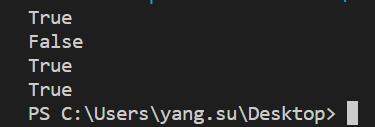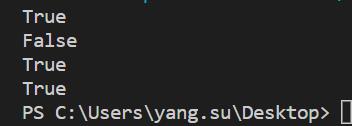函数:startswith()
作用:判断字符串是否以指定字符或子字符串开头
一、函数说明
语法:
string.startswith(str, beg=0,end=len(string)) 或 string[beg:end].startswith(str)
参数说明:
string: 被检测的字符串 str: 指定的字符或者子字符串。(可以使用元组,会逐一匹配) beg: 设置字符串检测的起始位置(可选) end: 设置字符串检测的结束位置(可选)
如果存在参数 beg 和 end,则在指定范围内检查,否则在整个字符串中检查
返回值
如果检测到字符串,则返回True,否则返回False。默认空字符为True
函数解析:如果字符串string是以str开始,则返回True,否则返回False
我们来看看例子
name = "sulao notebook"
print(name.startswith('su'))
print(name.startswith('lao'))
print(name.startswith('lao', 2))
print(name.startswith('note', 6, 10))打印的结果

我们看到如上图,需要介绍的是beg参数和end参数,beg参数第一位是0,然后是end参数应该是整个你要匹配的范围+1
同时我们还可以匹配元祖
name.startswith(('s','u','k'))匹配元祖这个我感觉和endswith没差别了
例如我们来看endswith的例子,和上面一样都能匹配True
name.endswith(('s','u','k'))函数:endswith()
作用:判断字符串是否以指定字符或子字符串结尾,常用于判断文件类型
一、函数说明
语法:
string.endswith(str, beg=[0,end=len(string)]) string[beg:end].endswith(str)
参数说明:
string: 被检测的字符串 str: 指定的字符或者子字符串(可以使用元组,会逐一匹配) beg: 设置字符串检测的起始位置(可选,从左数起) end: 设置字符串检测的结束位置(可选,从左数起)
如果存在参数 beg 和 end,则在指定范围内检查,否则在整个字符串中检查
返回值:
如果检测到字符串,则返回True,否则返回False。
解析:如果字符串string是以str结束,则返回True,否则返回False
注:会认为空字符为真
我们来看例子
name = "sulao notebook"
print(name.endswith('book'))
print(name.endswith('lao'))
print(name.endswith('book', 10))
print(name.endswith('note', 6, 10))
